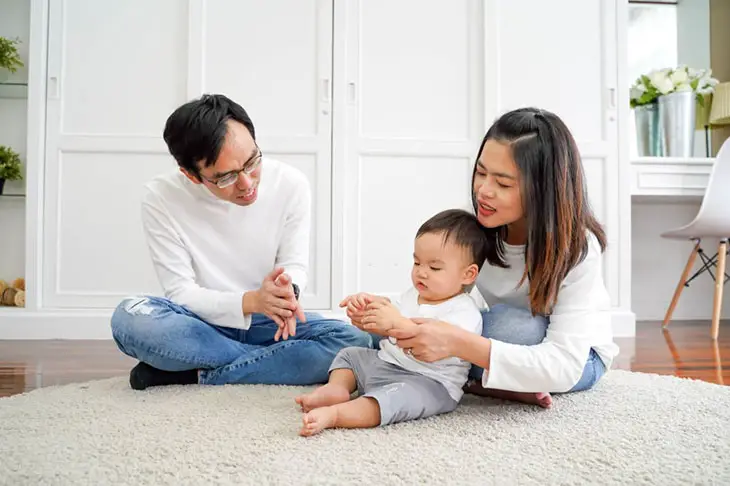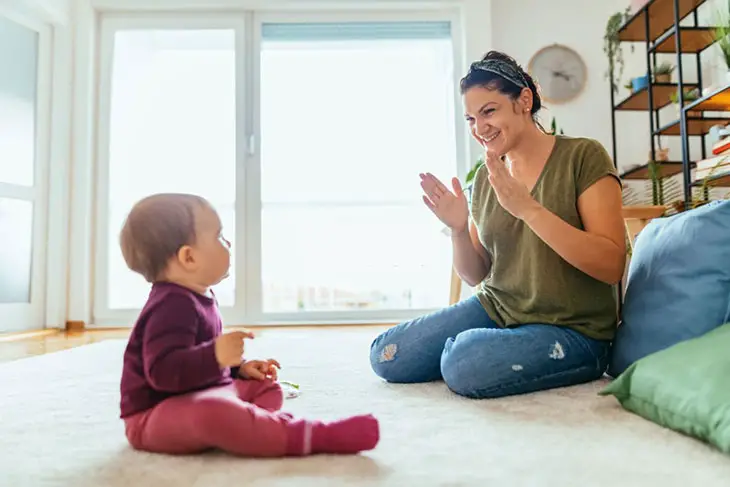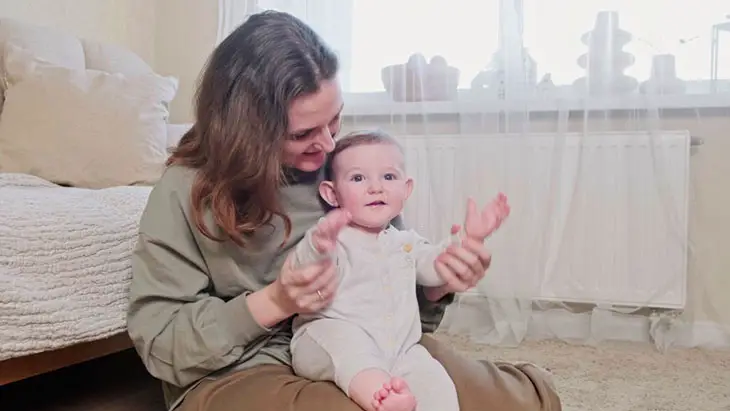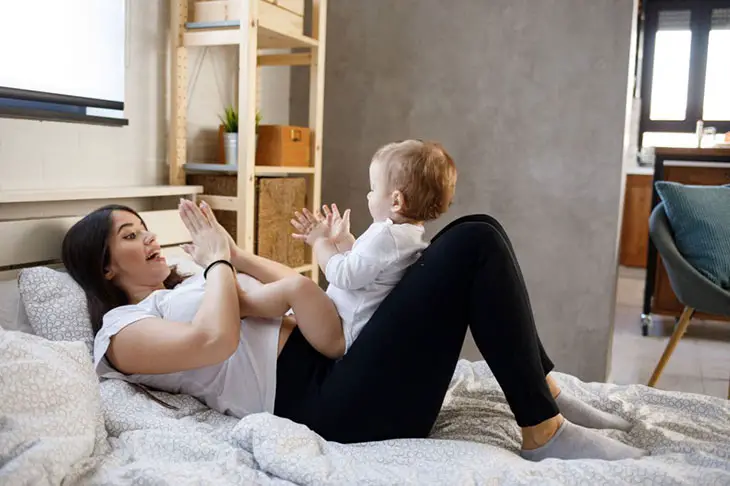For newborns, the time between 6 and 12 months of age is pivotal.
It is when a kid experiences numerous significant developmental milestones, including the eruption of a tooth, the first time calling mother, and the first steps of life.
But some mothers are worried: Why is my baby not clapping at 12 months?
Scrolling down our article to the relevant section can help you locate the solution quickly. We will provide you with additional helpful information to help you comprehend the significance of clapping and how to get your child to clap.
Why Is My Baby Not Clapping At 12 Months?

Therefore, there is not much serious concern until your child is at least 12 months old.
After that, if your infant isn’t clapping despite witnessing you do it, it may indicate a physical or social skill development interruption.
Your toddler may have a developmental issue if they can’t clap and exhibits indicators of social incompetence. The baby may not smile, not beg for attention, or not babble as a result of this delay.
Suppose the toddler’s inability to clap is coupled with additional symptoms such as needing help to sit up or to reach for a toy or another child.
It is advisable to visit a doctor as it may indicate some growth delay in the babies such as language delays or potential malfunction, delusion, and anxiety.
Why Is Clapping Important For Your Baby?
Why is clapping a milestone for your sweetheart? Babies usually start imitating clapping around the age of six months.
However, the first few claps may get botched misses, which marks a significant development in your sweetheart and maybe the baby sign language.
At 6-9 months, your baby often mimics others and practices fine motor control by learning to clap.
Indeed, clapping indicates much more than delight. It also reflects nearly a year’s worth of effort and growth.
A clapping infant is not only a happy baby. Clapping is also a form of communication behaviors for newborns that involves coordination and focus of parents.
Also, applause is an excellent method for teaching children about syllables.
Toddlers who understand that words may be split down into smaller portions grasp the basics of word recognition more easily.
Combining clapping and singing helps toddlers develop their sense of beat and melody.
How To Teach Baby To Clap?
How can I get my 1 year old to clap? Let us reveal our secrets!
Model Clapping

Babies tend to copy their parents easily, so model clapping for them is a good starting point. Clap your hands together as you play on the floor.
To keep your child interested and involved, you might create exaggerated gestures or try applauding at varying speeds.
When the infant achieves something excellent or accomplishes anything, mom and dad should clap and cheer.
At the time, parents are teaching kids that clapping is an appropriate response to an accomplishment.
Use Hand-Over-Hand Guidance

You may also practice applauding and attempt to lead your baby’s hands to do the same. Remember to have a grin on your face when clapping and cheering.
If there is a significant reaction at the end, your baby will be more engaged in learning something new.
That is not enough. You must be gentle, and you may place your baby in your lap and lead their actions from behind, or you can sit in front of them and teach them.
You should be kind, patient, and supportive in any case and pause if they don’t want to do it many times.
Play Hand Games

To assist your infant start clapping, you might refer to some classic hand-clapping games and activities like Pat-A-Cake. Your infant will continually request to play if they are having fun and are excited.
A fantastic interactive technique to play with your child and promote applause is to listen and clap along to the song “If You’re Happy and You Know.”
Practice High-Fives
High-fives are the next technique to stimulate clapping in kids. It is akin to clapping and a wonderful exercise for combining hand and eye.
Babies will also understand that clapping and high-fiving make the same sound.
And they learn that applauding and high-fives are used to congratulate as they become older and will be eager to join in the joy.
In short, this method improves hand-eye coordination and teaches your child that clapping their hands together indicates a happy event.
Clap Along To Music

Using music is a clever trick to trigger your young child to applaud! You may experiment with clapping to different types of music with varied rhythms and rates.
Clap hand-in-hand with your child while holding them in your lap, or you can clap while they watch.
If you have the chance to bring your infant to an event with musical performances for kids, they will learn to clap quickly and even dance along to the music.
By doing this, you are developing your kid’s communication, fine motor skills, and interpersonal abilities.
Use A Mirror

Toddlers will like playing with themselves in the mirror since they enjoy observing themselves. You can stay close to your baby to let your baby see you applauding via the mirror.
Toddlers will find what they see in the mirror fascinating as they develop the coordination necessary to join their hands.
Keep in mind that if the baby stopped clapping or responding after applying those above methods, it would be best to refer to the baby development book.
Or, you’d better contact a doctor to check your child’s health.
Related Questions & Answers
What Age Do Babies Wave Bye Bye?
Although all babies develop at different rates, they normally can wave bye bye during the 7th or 8th month.
If you worry about your baby not waving at 12 months, it’s advisable to find various effective ways to encourage your baby to do so.
When Should Babies Start Pointing?
Along with other motions like waving bye-bye, baby pointing is a crucial body language development milestone.
Between 7 and 15 months old, babies begin to point. Most infants can gesture toward objects that pique their interest.
What Should A 1yr Old Be Doing?
By 12 months, they can express more facial movements; plus, they can walk and stand straight by themselves but are still not stable.
They can dance to music, play with push and pull toys, make a building block, catch a ball game, recognize colorful objectives, and sit on a little stool or chair.
Your 12-month-old child may imitate animal noises or sounds and enunciate four to six short syllables by the age of one.
At that period, parents will even face the matter and be confused: Why does my baby scratch everything or baby standing on head?
Sometimes, your little one always fusses, and the baby won’t let parents sit down. But don’t fret; that’s how they explore the world and express their feelings.
Recap
Hopefully, through the article, parents have answered the question: Why is my baby not clapping at 12 months?
There are other ways to support this developmental milestone as well, particularly how to encourage babies to applaud that we’ve discussed. Baby clapping developmental milestones are always extremely obvious.
Be brave and take your infant to the pediatric clinic for a checkup if you’re concerned that they aren’t keeping up with many of their peers.
